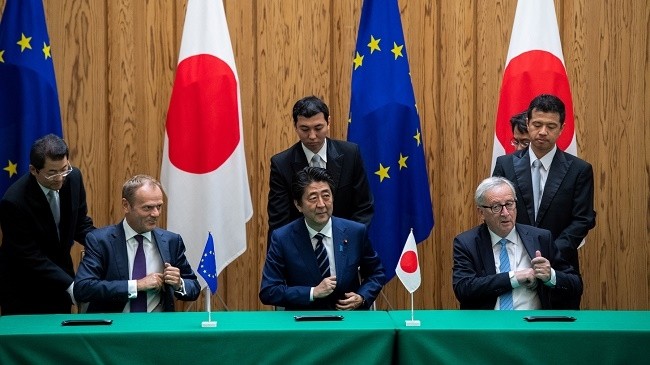Up to now, JEFTA has created the largest free trade area in the world, with a total population of 639 million and a 30% share of the global gross domestic product (GDP). Under the agreement, Japan will remove tariffs on 94% of its imports from the EU, mainly agro-fishery products. The EU will also lift import duties on 99% of Japanese goods. Remarkably, the EU will not impose tariffs on key Japanese commodities, including automobiles and televisions, after eight and six years from when the JEFTA takes effect. The two sides will exert efforts to accelerate the parliaments’ ratification of the JEFTA so that such a historic deal can come into force in late March 2019, coinciding with the projected time for the UK leaving the EU.
When the JEFTA was signed on July 17, in Tokyo, Japanese Prime Minister Shinzo Abe described it as evidence that affirmed the superiority of free trade versus protectionism. President of the European Council, Donald Tusk, also stated that the JEFTA is a clear action against trade protectionism, while President of the European Commission, Jean-Claude Juncker, emphasised the agreement delivers a strong message on free and fair trade, asserting that the cooperation will help the parties to become stronger and wealthier.
Initiated in 2013, the JEFTA did not attract the attention of the European public, partly because it coincided with the negotiations on the Transatlantic Trade and Investment Partnership (TTIP) between the EU and the US, and the Comprehensive Economic and Trade Agreement (CETA) between the EU and Canada. However, after the US withdrew from the Trans-Pacific Partnership (TPP), a process in which Japan had set a lot of expectations, Tokyo has turned to accelerating its negotiations with the EU. After four years of persistent negotiations, the EU and Japan agreed on the final content of the JEFTA one day before the G20 summit opened in Germany on July 7, 2017, during which US President Donald Trump took advantage of the forum to defend his America First” policy.
The benefits from the JEFTA are undeniable, for both the EU and Japan. As estimated by experts, after trade barriers are lifted between the two sides, the EU’s exports to Japan will increase by 32.7%, while Japan’s exports to the EU market will also rise 23.5%. The EU member countries will receive specific benefits in the field of agribusiness and nutritional products. In return, Japan also has more advantages in the EU, especially in freely accessing the EU’s automobile market. European companies will also be free to supply goods, including those in the rail transport sector which inherently has a lot of advantages in the Japanese domestic market.
The official signing of the JEFTA at the present time is of significance, as the protectionism trend is increasing in the US, stemmed from President Trump’s “America First” policy. The EU, Japan, and many of the US’s long-standing allies, have been named in the list of countries and regions subject to Washington’s new import tariffs at a high and controversial level, sparking an outlook of a trade war outbreak. Born in that context, JEFTA is hailed by the participating parties as a strong protest against and a heavy blow to the US’s protectionism policy.
















